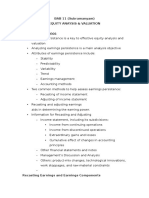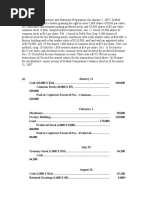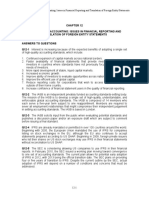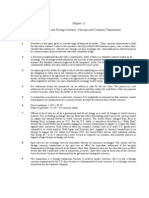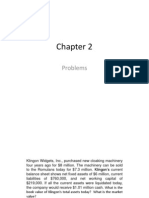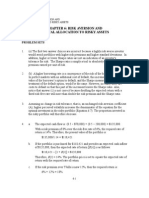Ifm - Case 12
Ifm - Case 12
Uploaded by
Patty CherotschiltschCopyright:
Available Formats
Ifm - Case 12
Ifm - Case 12
Uploaded by
Patty CherotschiltschOriginal Description:
Original Title
Copyright
Available Formats
Share this document
Did you find this document useful?
Is this content inappropriate?
Copyright:
Available Formats
Ifm - Case 12
Ifm - Case 12
Uploaded by
Patty CherotschiltschCopyright:
Available Formats
CASE 12
1. Why do you think Toyota waited so long to move much of its manufacturing for European sales to Europe? As the automobile industry is very capital intensive, Toyota wanted to continue pursuing economies of scale and scope. In addition to that, even though only 26% of the cars sold in Europe were manufactured there, Europe was still the second largest foreign market for Toyota. The European market sales were second only to North America where 60% of the manufacturing was done locally. With such numbers Toyota did not see it as a pressing issue to move manufacturing locally, as importing cars and components did not seem so risky, expensive and for that particular moment it worked well enough.
2. If Britain were the join the European Monetary Union, would the problem be resolved? How likely do you think it is that Britain will join? The contributors to the 26% European market sales which come from local manufacturing are Britain, Portugal and Turkey. Only Portugal has the Euro as official currency, Turkey has the Lira and Britain has the Pound. Britain joining the European Monetary Union (EMU) will not solve the problem as the Euro had been continuously falling against both the Japanese yen and British pound. Joining the EMU will eliminate only the pound/euro currency deviations but not the euro/yen deviations. Britain will not join the EMU, at least not any time soon, as the euro is not the most stable currency due to the crisis. Becoming part of the EMU and accepting the euro as a main currency means dependency which Britain does not want or need right now.
3. If you were Mr. Shuhei, how would you categorize your problems and solutions? What was a short-term and what was a long-term problem? Short-term problem: the current exchange-rate issues (the continuous falling of the euro against the yen and the pound) Long-term problem: manufacturing strategy (for some reasons the North American sales were supported by 100% local manufacturing, while in Europe not and this is where the costs and losses came from) Solutions: continue absorbing the yen costs until the market stabilizes and move manufacturing for the European market to European countries which are part of the EMU, i.e. move away from the facilities in Britain
4.
What measures would you recommend Toyota Europe take to resolve the continuing operating losses? Manufacturing of cars targeted for Europe should be moved to Europe. However, Toyota should consider moving its manufacturing facilities to countries within the European Monetary Union, as Britain does not seem to be working on joining any time soon. This way currency-related risks, deviations and losses will be eliminated. In addition to that, Toyota should prioritize among its market-share and profit-oriented goals and develop a proper strategy based on that prioritization.
You might also like
- The Controller of The Ijiri Company Wants You To Estimate A Cost Function From The Following Two Observations in A General Ledger Account Called MaintenanceDocument3 pagesThe Controller of The Ijiri Company Wants You To Estimate A Cost Function From The Following Two Observations in A General Ledger Account Called MaintenanceElliot RichardNo ratings yet
- BVA End Exam Qns AnsDocument9 pagesBVA End Exam Qns AnsYong RenNo ratings yet
- Bank Valuation and Value Based Management: Deposit and Loan Pricing, Performance Evaluation, and Risk, 2nd EditionFrom EverandBank Valuation and Value Based Management: Deposit and Loan Pricing, Performance Evaluation, and Risk, 2nd EditionRating: 1 out of 5 stars1/5 (1)
- Chapter 4 ExerciseDocument7 pagesChapter 4 ExerciseJoe DicksonNo ratings yet
- 10408065Document4 pages10408065Joel Christian MascariñaNo ratings yet
- Latihan Soal Sesi 3 - Nastiti Kartika DewiDocument26 pagesLatihan Soal Sesi 3 - Nastiti Kartika DewiNastiti KartikaNo ratings yet
- Assignment 5-2020Document2 pagesAssignment 5-2020Muhammad Hamza0% (4)
- FSA 8e Ch05 SMDocument39 pagesFSA 8e Ch05 SMnufusNo ratings yet
- Investment Analysis - Chapter 7Document36 pagesInvestment Analysis - Chapter 7Linh MaiNo ratings yet
- BAB 11 - SubramanyamDocument8 pagesBAB 11 - SubramanyamServitalle100% (1)
- FSA 8e Ch07 SMDocument60 pagesFSA 8e Ch07 SMdesy nataNo ratings yet
- CR Par Value PC $ 1,000 $ 40: 25 SharesDocument4 pagesCR Par Value PC $ 1,000 $ 40: 25 SharesBought By UsNo ratings yet
- FSA 8e Ch04 SMDocument63 pagesFSA 8e Ch04 SMmonhelNo ratings yet
- CH 2 Investment Alternatives Generic PriciplesDocument34 pagesCH 2 Investment Alternatives Generic PriciplesAbdihamid AliNo ratings yet
- B392 Tma - QQQ Fall 2023-2024Document10 pagesB392 Tma - QQQ Fall 2023-2024adel.dahbour97No ratings yet
- Question and Answer - 60Document31 pagesQuestion and Answer - 60acc-expertNo ratings yet
- Chapter 16, Modern Advanced Accounting-Review Q & ExrDocument25 pagesChapter 16, Modern Advanced Accounting-Review Q & Exrrlg4814100% (4)
- Problems For CBDocument28 pagesProblems For CBĐức HàNo ratings yet
- Intercompany Inventory and Land Profits: Solutions Manual, Chapter 6Document40 pagesIntercompany Inventory and Land Profits: Solutions Manual, Chapter 6HelloWorldNowNo ratings yet
- Capital Structure Decisions: Part I: Answers To End-Of-Chapter QuestionsDocument8 pagesCapital Structure Decisions: Part I: Answers To End-Of-Chapter Questionssalehin1969No ratings yet
- Instant Download Principles of Managerial Finance 16th Edition Chad J Zutter Scott B Smart PDF All ChaptersDocument79 pagesInstant Download Principles of Managerial Finance 16th Edition Chad J Zutter Scott B Smart PDF All Chaptersakkatonos100% (2)
- Forecasting Financial StatementsDocument58 pagesForecasting Financial StatementsEman KhalilNo ratings yet
- Chapter 3 Stocks and Bond ValuationDocument101 pagesChapter 3 Stocks and Bond ValuationYến NhiNo ratings yet
- Return On Invested Capital and Profitability AnalysisDocument34 pagesReturn On Invested Capital and Profitability AnalysisshldhyNo ratings yet
- 2010 08 21 - 011638 - P15 1Document3 pages2010 08 21 - 011638 - P15 1Happy MichaelNo ratings yet
- Birch Paper Company Case Study SolutionsDocument3 pagesBirch Paper Company Case Study Solutionsmina hannaNo ratings yet
- Financial Accounting Disclosure Makalah ImamDocument16 pagesFinancial Accounting Disclosure Makalah ImamImam AhmadNo ratings yet
- Chap 11 - Equity Analysis and ValuationDocument26 pagesChap 11 - Equity Analysis and ValuationWindyee TanNo ratings yet
- Acg5205 Solutions Ch.16 - Christensen 12eDocument10 pagesAcg5205 Solutions Ch.16 - Christensen 12eRyan NguyenNo ratings yet
- MGT 531Document5 pagesMGT 531rizwan aliNo ratings yet
- Soal GSLC-6 Advanced AccountingDocument2 pagesSoal GSLC-6 Advanced AccountingEunice ShevlinNo ratings yet
- SMChap 006Document63 pagesSMChap 006Rola KhouryNo ratings yet
- Chapter 5 - How Do Risk and Term Structure Affect Interest RatesDocument59 pagesChapter 5 - How Do Risk and Term Structure Affect Interest Ratesmichellebaileylindsa0% (1)
- Arya Bima Putra - 215020300111071 - CH - Tugas1Document3 pagesArya Bima Putra - 215020300111071 - CH - Tugas1Arya Bima PutraNo ratings yet
- Solution Cash BudgetDocument7 pagesSolution Cash BudgetJames WisleyNo ratings yet
- Chapter 5 - Group DisposalsDocument4 pagesChapter 5 - Group DisposalsSheikh Mass JahNo ratings yet
- FSA - Tutorial 5 Analyzing Investing Activities Part 2Document2 pagesFSA - Tutorial 5 Analyzing Investing Activities Part 2KHOO TAT SHERN DEXTONNo ratings yet
- Chapter 12 Solution ManualDocument68 pagesChapter 12 Solution ManualRiskaNo ratings yet
- 109Document34 pages109danara1991No ratings yet
- Lecture 10 - Prospective Analysis - ForecastingDocument15 pagesLecture 10 - Prospective Analysis - ForecastingTrang Bùi Hà100% (1)
- Chapter 16Document29 pagesChapter 16get goldNo ratings yet
- Multiple Choice Questions: Analyzing Operating ActivitiesDocument22 pagesMultiple Choice Questions: Analyzing Operating ActivitiesAnh LýNo ratings yet
- Rangkuman Chapter 9 Cost of CapitalDocument4 pagesRangkuman Chapter 9 Cost of CapitalDwi Slamet RiyadiNo ratings yet
- CHPT 12 Derivatives and Foreign Currency: Concepts and Common TransactionsDocument9 pagesCHPT 12 Derivatives and Foreign Currency: Concepts and Common TransactionsKamran ShafiNo ratings yet
- Case - Ohio Rubber Works Inc PDFDocument3 pagesCase - Ohio Rubber Works Inc PDFRaviSinghNo ratings yet
- Chapter 2Document17 pagesChapter 2jinny6061100% (1)
- ch#5 of CFDocument2 pagesch#5 of CFAzeem KhalidNo ratings yet
- Solved - Excerpts From The Annual Report of Lands' End Follow ($...Document2 pagesSolved - Excerpts From The Annual Report of Lands' End Follow ($...Iman naufalNo ratings yet
- Ch01 Introduction To Business Combinations and The Conceptual FrameworkDocument51 pagesCh01 Introduction To Business Combinations and The Conceptual Frameworkmariko1234100% (1)
- Daniels Ib13 06Document24 pagesDaniels Ib13 06abhishekkumar2139No ratings yet
- Kelompok 5 Soal TerjemahanDocument1 pageKelompok 5 Soal TerjemahanElgaNurhikmahNo ratings yet
- Chapter 17Document21 pagesChapter 17pvaibhyNo ratings yet
- Chapter 6: Risk Aversion and Capital Allocation To Risky AssetsDocument14 pagesChapter 6: Risk Aversion and Capital Allocation To Risky AssetsBiloni KadakiaNo ratings yet
- Udah Bener'Document4 pagesUdah Bener'Shafa AzahraNo ratings yet
- Chapter 12 SolutionsDocument113 pagesChapter 12 Solutionsgottwins050% (1)
- Financial Statement Analysis: K R Subramanyam John J WildDocument40 pagesFinancial Statement Analysis: K R Subramanyam John J WildManusha ErandiNo ratings yet
- Ch. 15 Capital StructureDocument69 pagesCh. 15 Capital StructureScorpian MouniehNo ratings yet
- Cost Of Capital A Complete Guide - 2020 EditionFrom EverandCost Of Capital A Complete Guide - 2020 EditionRating: 4 out of 5 stars4/5 (1)
- Decoding DCF: A Beginner's Guide to Discounted Cash Flow AnalysisFrom EverandDecoding DCF: A Beginner's Guide to Discounted Cash Flow AnalysisNo ratings yet
- Cost Estimating ComponentsDocument42 pagesCost Estimating Componentsangelica suazoNo ratings yet
- Online Tax Payment PortalDocument1 pageOnline Tax Payment Portalminatibehera948No ratings yet
- Nazara Technologies IPO PDFDocument411 pagesNazara Technologies IPO PDFtakeg40428No ratings yet
- Chapter 1: Concepts of Entrepreneurship: I. The EntrepreneurDocument5 pagesChapter 1: Concepts of Entrepreneurship: I. The EntrepreneurChristian Rivera100% (1)
- Drury 11th Edition Appendix 3.1Document5 pagesDrury 11th Edition Appendix 3.1wieschallajanineNo ratings yet
- Jitu Virwani and His Journey To The TopDocument2 pagesJitu Virwani and His Journey To The TopJithu VirwaniNo ratings yet
- Chapter 1 Business Combinations PROBLEM 2 - TRUE or FALSEDocument4 pagesChapter 1 Business Combinations PROBLEM 2 - TRUE or FALSElatte aeriNo ratings yet
- C8 Module 6 International Marketing (2014!11!25 06-10-22 UTC)Document20 pagesC8 Module 6 International Marketing (2014!11!25 06-10-22 UTC)Kristen NallanNo ratings yet
- In Participating Airport LoungesDocument1 pageIn Participating Airport LoungesFaizan AhmadNo ratings yet
- Material Managemnt: From The Management Point of View, The Key Objectives of MM AreDocument11 pagesMaterial Managemnt: From The Management Point of View, The Key Objectives of MM ArejoeyNo ratings yet
- Mutual Funds ReportDocument8 pagesMutual Funds Reporti6178717No ratings yet
- Foreign Exchange Operation of Commercial BankDocument24 pagesForeign Exchange Operation of Commercial BankShawon100% (1)
- British American Tobacco Bangladesh (BAT)Document3 pagesBritish American Tobacco Bangladesh (BAT)Noor Islam FahadNo ratings yet
- Ielts Line Graph ExerciseDocument2 pagesIelts Line Graph ExerciseWai Man LeeNo ratings yet
- Chapter 1 Tutorial QuestionsDocument2 pagesChapter 1 Tutorial QuestionsMilanNo ratings yet
- P 16-3 PDFDocument2 pagesP 16-3 PDFNatasha PNo ratings yet
- Chilufya Research WordDocument14 pagesChilufya Research Wordlulu mkwananziNo ratings yet
- Section15 - Komatsu Handbook Edition 30 - 2009 PDFDocument24 pagesSection15 - Komatsu Handbook Edition 30 - 2009 PDFEna LouloudakiNo ratings yet
- Air Hoists ProfiDocument6 pagesAir Hoists ProfiAhmedNo ratings yet
- 952085825042023INPTPBSB21250420230811Document5 pages952085825042023INPTPBSB21250420230811Eva Akash100% (1)
- S&P 500 MapDocument1 pageS&P 500 MapMuhd Nur IrfanNo ratings yet
- Bank FinTech Online Study Pack 2020Document41 pagesBank FinTech Online Study Pack 2020contactpulkitagarwalNo ratings yet
- ABM 007 / Applied Economics Day 16: Differentiating Types of CustomersDocument7 pagesABM 007 / Applied Economics Day 16: Differentiating Types of CustomersSeventeen CartNo ratings yet
- Pakistan Development Review - V61i4 PDFDocument158 pagesPakistan Development Review - V61i4 PDFBushra AhmedNo ratings yet
- ABCD Secret PatternDocument17 pagesABCD Secret PatternTotok Sgj100% (1)
- PNB SEC 17-A - 31 Dec 2019 PDFDocument324 pagesPNB SEC 17-A - 31 Dec 2019 PDFJiordan Gabriel SimonNo ratings yet
- Mission Ac Saad Test - 01 QP FinalDocument12 pagesMission Ac Saad Test - 01 QP Finalarun100% (1)
- STATE OF THE NATION ADDRESS 2020 Pres MasisiDocument70 pagesSTATE OF THE NATION ADDRESS 2020 Pres MasisiTkMosNo ratings yet
- InvestmentDocument10 pagesInvestmentfebysilabanNo ratings yet
- Economic History of Nepal From 2950-1990Document25 pagesEconomic History of Nepal From 2950-1990Arpan AcharyaNo ratings yet









